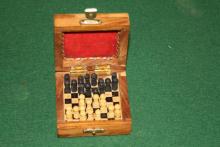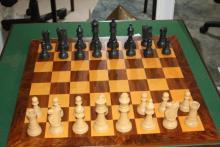Fianchetto basics
A Bishop developed in fianchetto reaches deep into the opponent's position and influences two important central squares.We can see this effect in IQP positions.


















































































Commonly in isolated Queen-Pawn positions Black has a cramped position and White has chances for attacking the King.


















































































When an IQP faces a fianchetto, Black has two advantages over the standard formation: extra pressure on the isolated Pawn, and an extra-strong defensive phalanx on the light squares.
We can see this in Rubinstein’s line in the Tarrasch Defence. 1. d4 d5 2. c4 e6 3. Nc3 c5 4. cxd5 exd5 5. Nf3 Nc6 6. g3


















































































If the opponent tries to block the long diagonal with Pawns, you can lever open the line again with your own Pawns.
This is a simple plan which can be played by either side. I have played dozens of games like this.


















































































A castled fianchetto position can be a very hard nut to crack - for example, h7 is difficult to get to. The Pawns cover the dark squares and the Bishop covers the light squares.
However, there is a recipe for attacking the castled King's fianchetto position.
The weaknesses created by the g2-g3 move can be used by the opponent to get at the King: either by getting pieces into the holes (f3 and h3), or by using the h-Pawn to lever open the h-file, or some combination of these ideas. If the Bishop is removed, all that will be left is a network of holes.


















































































Black has correctly tried to get at the King through the h-file, particularly h3. If White plays Bxh3, the Black Queen will leap onto the doorstep of the White King. Another clever point is: Black has held the Bishop on h3 while advancing the h-Pawn, so White cannot meet ...h7-h5 with h2-h4, blockading the h-file.
Here Black should play 1...hxg3 with the idea of 2. hxg3 Bxg2 3. Kxg2 Qh3+ mating.
This attacking scheme is not very quick to set up, but works like clockwork.
"I had won hundreds of five-minute games in similar positions and had it down to a science: lever open the h-file... sac, sac ... and mate!" - Bobby Fischer
Lee,R - Holmes,D [E82] BCCC 1969-70 1.d4 Nf6 2.c4 g6 3.Nc3 Bg7 4.e4 d6 5.f3 0-0 6.Be3 b6 7.Qd2 c5 8.d5 Na6 9.0-0-0 Nc7 10.Bh6 a6 11.g4 b5 12.h4 bxc4 13.Bxc4 Nb5 14.Nge2 Nxc3 15.Nxc3 Bd7 16.h5 Qe8 17.hxg6 fxg6 18.Bxg7 Kxg7 19.Qh6+ Kh8 20.e5 dxe5 21.d6 exd6 22.Rxd6 Qe7 23.Rxf6 Rxf6 24.Nd5 Qg7 25.Nxf6 1-0
Homer,S - Wilde,T [B07] Devon vs. Cornwall, 06.02.1999 1.e4 d6 2.d4 Nf6 3.Nc3 g6 4.Be2 Bg7 5.h4 h6 6.Be3 0-0 7.h5 Kh7 8.hxg6+ fxg6 9.Qd2 Ng8 10.0-0-0 Nc6 11.Nf3 Qe8 12.Rh4 h5 13.g4 Nf6 14.gxh5 gxh5 15.Rdh1 Rh8 16.Nd5 Nxd5 17.Rxh5+ Kg8 18.Rxh8+ Bxh8 19.Rg1+ Bg7 20.exd5 Nd8 21.Bh6 1-0
![[Cool Blue Cat says:]](/chessx/cool_cat.gif)
I must emphasise the importance of this plan. There are several standard attacks which you must be able to play - this is one of them - and where it often seems the attack is easier to play than the defence. If you ever intend to play a fianchetto system, your opponents can trot out this plan almost without thinking, and if you get your counterattack wrong you will almost certainly be checkmated. In every opening where there is a King's-side fianchetto you can expect to find a critical line where the opponent tried to checkmate down the h-file.


















































































Having placed your Bishop on the long diagonal you need to be careful how you place your central Pawns. If they sit about in front of the Bishop they limit its reach until they move; if they become blocked they can choke it for a long while.
On the other hand, leaving your central Pawns unmoved leaves the centre free for your opponent! So fianchetto openings are difficult to handle, particularly in how you play in the centre. This is part of the attraction of fianchetto systems: they are difficult and so grandmasters can hope for their GM opponents to go astray at some point.
Fianchetto Openings
Fianchettoes turn up frequently in closed Queen's-Pawn openings, and there is a Fianchetto Variation for White in each of the Indian Defences (semi-closed openings).
King's Indian: 1. d4 Nf6 2. c4 g6 3. Nc3 Bg7 4. Nf3 O-O 5. g3
Grunfeld: 1. d4 Nf6 2. c4 g6 3. g3 d5
Queen's Indian: 1. d4 Nf6 2. c4 e6 3. Nf3 b6 4. g3
And most recently, Kasparov has experimented with:
Nimzo Indian: 1. d4 Nf6 2. c4 e6 3. Nc3 Bb4 4. g3
But the history of the fianchetto is particularly bound up with the history of the flank (hypermodern) openings.
Reti and his contemporaries rejoiced in the fianchetto, arguing that you did not need to occupy the centre as White as long as you controlled it.
The diagram is from Reti-Lasker, New York 1924. We can see that Reti has allowed Lasker to occupy the centre but Rtei has fianchettoed both Bishops to hit back at this, and has even backed up his Bb2 with a Queen on a1!


















































































1.Nf3 d5 2.c4 c6 3.b3 Bf5 4.g3 Nf6 5.Bg2 Nbd7 6.Bb2 e6 7.O-O Bd6 8.d3 O-O 9.Nbd2 e5 10.cxd5 cxd5 11.Rc1 Qe7 12.Rc2 a5 13.a4 h6 14.Qa1 Rfe8 15.Rfc1


















































































This is the outline of the Catalan Opening (1. d4, 2. c4, 3. g3). White combines a fianchetto with both a central stake on d4 and pressure on Black's centre with c2-c4. Black can try to reinforce d5 with moves like ...e6 and ...c6, but this is rather passive.
Black can stop the fight for the d5 point by ...d5xc4, but this gives White a central majority and opens up the long light diagonal.


















































































This is a development we often see in the English Opening (1.c4). White uses the pressure of the fianchettoed Bishop to strike at the Black Queen's-side.
Having plonked a Pawn on c4, it makes sense to let the light-squared Bishop peer around the side of it; we see the same development by Black in many closed Sicilian systems and in the Benoni and Dutch Defences, where Black fianchettoes to avoid the Bishop’s Pawn. In each case the fianchettoed Bishop can used to support a Pawn advance.


















































































The Reti-Barcza system beginning with 1. Nf3 reserves all White's options.
This is a rather slow, subtle opening system which is difficult for all players to handle.


















































































White can expand on the King's-side, centre or Queen's-side (west, south-west, south).
The King's-side expansion is known as the King's Indian Attack, and is often played by players of 1.e4 against half-open defences like the French. It's another clockwork attack.






















































 W
W











































































































The fianchetto can also be tried in e-Pawn games, particularly the half-open defences - we have mentioned the King's Indian Attack against the French, and the Pirc and Modern Defences are based upon a Black King's-side fianchetto. White has also tried a fianchetto of the King's Bishop in many lines of the Sicilian, Open and Closed.
Closed Sicilian: 1. e4 c5 2. Nc3 Nc6 3. g3 g6
Open Sicilian: 1. e4 c5 2. Nf3 e6 3. d4 cxd4 4. Nxd4 Nf6 5. Nc3 d6 (Scheveningen Variation) 6. g3
Sicilian: 1. e4 c5 2. Nf3 e6 3. b3


















































































1.e4 c5 2.Nf3 d6 3.d4 cxd4 4.Nxd4 Nf6 5.Nc3 g6
In the open Sicilian, Black may post the dark-squared Bishop on the long diagonal without fear that it may be stifled by Pawns. The Dragon Bishop is a fearsome creature, particularly if White castles Queen's-side hoping to carry out the clockwork attack against Black's King's-side. Black already has a half-open c-file against White's own King!
Conclusion
The fianchetto is one of the basic building-blocks of chess thinking. Although it is associated with some of the most complex opening systems that are played by GMs, you are bound to come across it, and should at least know how to attack a castled King which is also hiding behind a fianchetto.





























































